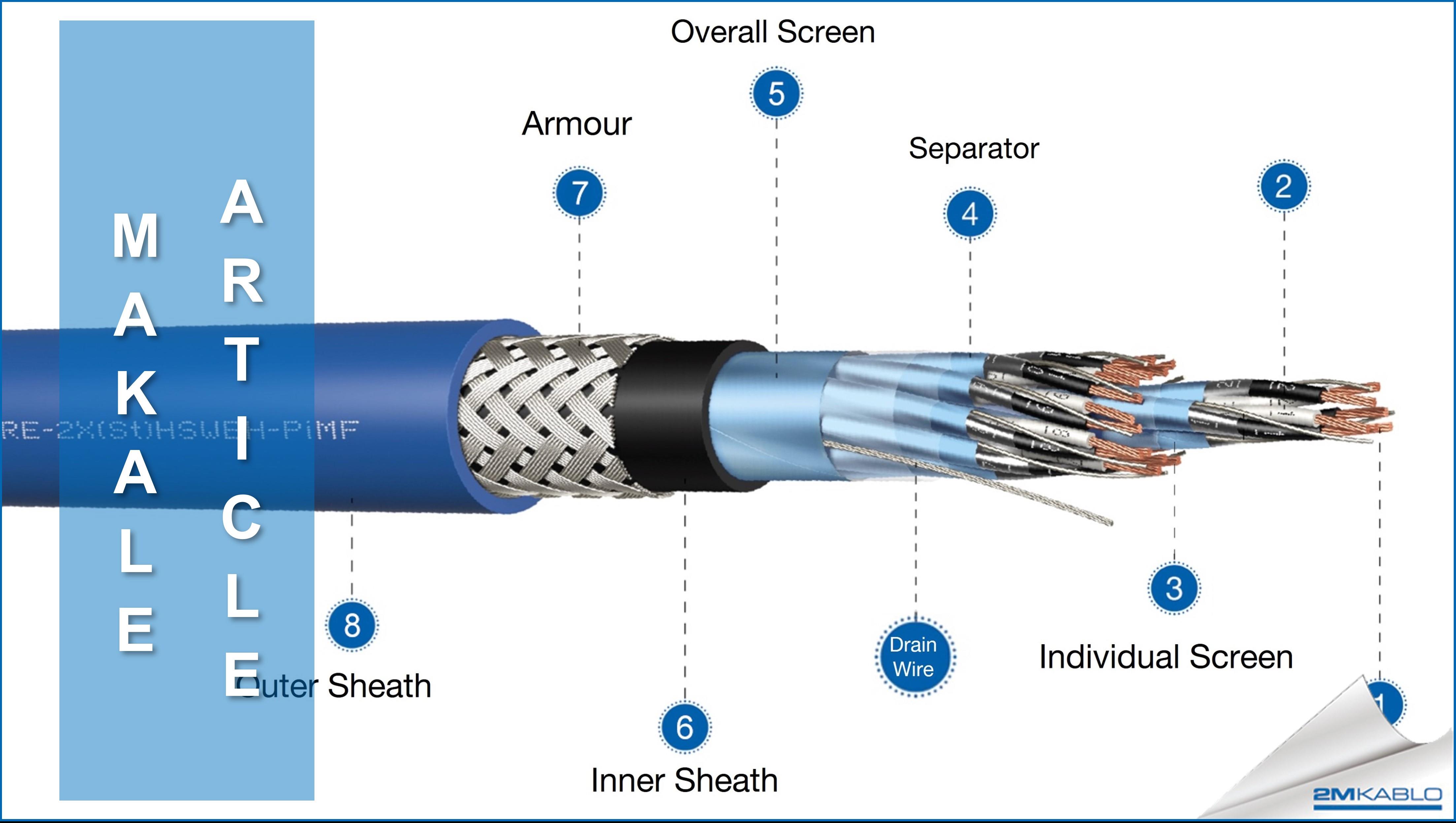Instrumentation Cable Layers
27/07/2023

Conductor
The conductors of the instrumentation cables consist of bare or tinned copper, which conforms to the conductor standards. These coppers can consist of solid (mono, single wire) or stranded wires. The selection criteria of conductor in these cables is their information suitable for resistance and size calculations of the cable.resistance values. It is important in cross-section


Insulation
Insulating materials can be vary according the developing materials technology. Basically, the following materials are used in instrumentation cables;
- PVC (Polyvinyl chloride)
- PE (Polyethylene)
- XLPE (Cross-linked Polyethylene)
- PP (Polypropylene)
- HFFR (Halogen free flame retardant compound)
- Silicone
- EPR (Ethylene propylene rubber)

Individual Screen
Individual screen is applied to each element in the twist. The cores can be grouped as pair, triple and quadruple. For example; PiMF in instrumentation cables means two cores are twisted and screened. TiMF" means for three cores twisted and screened while "QiMF" means four cores twisted screened.

Separators
Cable type can be important in the choice of the separator. Separators;
- Polyester tape (PET): Used for separating the elements / layers and to form the bundles of cores / sub-elements such as pairs, triads, quad.
- Laminated tapes (PET, Al-PET, Cu-PET): Used for screening purpose to prevent electromagnetic interference. Mostly used with a drain wire.
- Glass fiber and mica tape: For fire rated cables, used to create a barrier between conductive surfaces or prevent flame to reach to the assembled layers
* Inner sheath: Further information in «inner sheath» part.

Overall Screen
The assembled cores are screened by using Al-PET foil and drain wire with electrical contact to metallic surface of the foil. In cable codification, C is the symbol of concentric copper wires & (St) is the symbol of the foil screen with drain wire.

Screen
Screening is the practice of reducing the electromagnetic field in a space by blocking the field with barriers made of conductive or magnetic materials. Screening prevents the transmitted signal from being disturbed by natural or unnatural signals. Screening allows the cable to be electromagnetically protected against interferences. Different screening structures are mentioned in the literature. Some of those;
- AL-PET foil + drain wire
- Braid/spiral wires with bare copper or tinned copper wires,
- Semi-conductive layers (brushed graphite, tape and extruded material)
Screening Methods of Instrumentation Cables:
- Braid Screen (Cu, SnCu )
- Foiling/Taping (Al-PET , Cu-PET, … metallic or metal laminated plastic foils)
Braid/Spiral wires
Braid is produced from aluminum, silver, tinned copper and bare copper wires. Its appearance is in the form of a braid. Braid is much more flexible and suitable for continuous bending compared to the metallic foils/tapes. The screening performance is good. It can be applied with wires of different diameters.
In general case, as the optical coverage of braid/spiral screen increases, the screening performance of the cable improves.
Inner Sheath
Inner sheath is used to separate and protect cable core from metallic armour. It provides a uniform circular shape on cable core to prepare a proper surface for armouring process. Another adventagues of inner sheath is to increase mechanical strength. Depending on materials, inner sheath may be useful for flame/fire behaviours.
.jpg)
Armour
Another components of the cable is “armour”. Applied on an inner sheath, filler or other separators.The purpose of armour is to provide mechanical protection. Mechanical protection protects the cable against external factors such as impact, cutting, crushing, rodents. Depending on its design, armour also provides support for screening and grounding.
Steel is mostly used in armour as primery material. Aluminum, copper and even some non-metallics are used as armour according to the applications’ needs.

SWA (Steel Wired Armoured)
.jpg)
- Wire type armoring,
- Single wire spiral winding
- Good mechanical strength
- Good tensile strength
- Good rodent resistance
- Bending performance is low
SWB (Steel Wire Braid)
.jpg)
- Good mechanical protection
- Low tensile strength
- Lower cable diameter
- Bending is better It is lighter than SWA
STA (Steel Tape Armour)
.jpg)
- High resistance to pressure and impact
- Rodent resistance is good
- Light
- Induction protection at lower frequencies
Steel Flat Wires Armour + Steel Tape

- Good mechanical protection
- Rodent resistance is good
- More flexible compared to STA
Outer Sheath
The outer sheath is the last element of the cable. Information such as manufacturer, tracking number, cable definition, cross-section, voltage is indicated with the text written on the sheath. A rip cord or an identification tape/stripes can be placed under the sheath. Sheath colors can be given in standards or special designs can be made according to sectoral applications. The outer sheath material protects the cable against various factors by poviding following characteristisc;
Fire resistance, flame retardancy, oil resistance, high-temperature resistance, gasoline, solvent and derivatives resistance, aliphatic and aromatic hydrocarbons resistance, bending, torsion resistance, rodent and pest resistance.

Written by: 2M KABLO
